Estimated reading time: 9 minutes
How important is Small Business to the United States economy?
This question is easy to answer; incredibly important. Since 1997, our firm has served small businesses with a menu of working capital and related services. As a result, we have witnessed the many ups and downs in the United States economy. Given the fact that our client’s lives are invested in their business they need to be nimble and smart to succeed in this challenging economic environment.
As I have documented in the past, the small business is the most important cog in the United States economy, after consumer spending. The facts, as documented by the Small Business Administration (SBA) are worth presenting again to show the importance of the small business sector in the US economy. For additional information, go to www.sba.gov, and search under “Advocacy”.
Consider these facts from the SBA:
- A small business is defined as an independent business having fewer than 500 employees. For most businesses, 500 employees is hardly a small business.
- In 2011, there were 28.2 million small businesses, and 17,700 firms with 500 employees or more.
- Over three quarters of small businesses were nonemployers; this number has trended up over the past decade, while employers have been relatively flat.
Most people don’t understand the magnitude of the small business sector in the United States. Utilizing data from the SBA, small businesses make up the following;
- 99.7% of United States employer firms
- 63% of net new private-sector jobs
- 48.5% of private-sector employment
- 42% of private-sector payroll
- 46% of private-sector output
- 37% of high-tech employment
- 98% of firms exporting goods
- and 33 % of exporting value.
- Source: U.S. Census Bureau, SUSB, CPS; International Trade Administration; Bureau Of Labor Statistics, BED; Advocacy-funded research, Small Business GDP: Update 2002-2010, www.sba.gov/advocacy/7540/42371
Most people assume that the majority of new jobs created in the United States over the past 20 years are in large or multinational businesses. In fact, the opposite has been the case, Small firms accounted for 63% of the net new jobs created between 1993 and mid-2013 (or 14.3 million of the 22.9 million net new jobs). Since the end of the recession (from mid-2009 to mid-2013), small firms accounted for 60% of the net new jobs.
What are some other facts about the importance of the small business sector in the United States? There is so much data available, but I have highlighted the more important facts about small businesses in the United States below.
I have been asked in the past “what kind of business in the United States creates more jobs, startups or existing businesses?” The answer to this needs to be relative to new business formation and death trends in the United States economy today. So what is the answer?
According to the Bureau of Labor Statistics – In the last two decades, about 60% of the private sector’s new jobs were created by existing businesses and about 40% by startups minus closures. While startups account for many new jobs in the United States economy, job losses from firms that close are equally important to account for when looking at the net effect of job creation and employment levels. This begs another question; how many small businesses open and close in the United States each calendar year? Has the number of openings and closings increased, decreased or stayed the same?
My research and findings using SBA data and United States Census Bureau information surprised me. I found somewhat conflicting data even on the SBA website so I did a little more research and decided to use the data from a longer period of time (1990 to 2011) as calculated by the U.S. Small Business Administration, Office of Advocacy, U.S. Census Bureau and the Administrative Office of the U.S. Courts.
In the period from 1990 to 2011, there have been a total of nearly 12.8 million business births and 12.2 million business deaths in the United States. Annual business births over the 20 years of data have averaged about 587,000 annually and deaths about 559,000 per year. The charts below document the data for business births and deaths over the entire period.
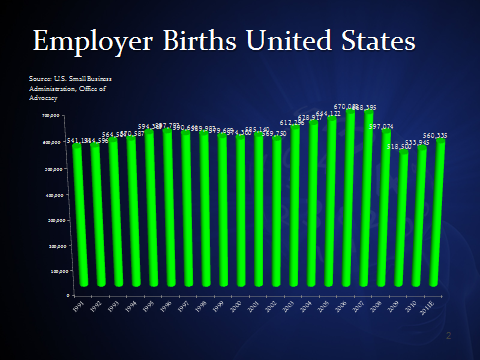
The charts are interesting and document how the numbers of annual business births and deaths have closely mirrored the performance of the overall United States economy. But I think in order to really understand what is currently affecting the United States economic in term of a lack of private sector job growth, we need to do some more detailed research partnering the two sets of data together.
Consider the following facts:
- When looking at business births on a standalone basis, the numbers appear to be pretty good.
- But then look at what has happened to business births since the year 2006 in the United States. Keep in mind that 2006 was part of the pre-recession period for the United States. In fact, the economy as measured by real GDP [see chart below} in the United States was actually in retrospect in pretty good shape.
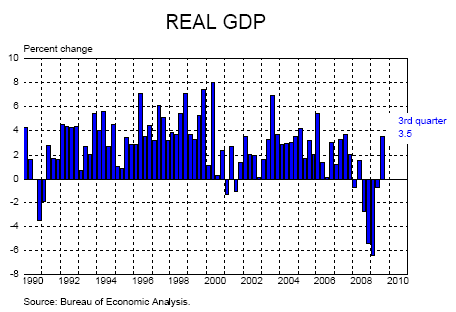
- Business births peaked in the United States in the year 2006, eclipsing 670,000 for the first time ever. By 2009, this number had dropped more than 22% to only 518,500 births for that year. Estimates for 2011 appear to show a small increase to about 560,000 business births.
The more significant change that has occurred in addition to the huge drop in births is what is happening to the number of business deaths annually in the United States. As we will see below, for the first time ever in the period for which data is available, business deaths are much larger than the number of businesses starting in the United States. This is a very concerning development.
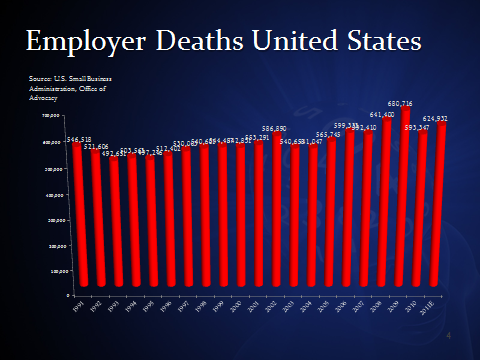
The numbers of businesses that are dying have been increasing for the past 10+ years in the United States. Giving the miserable state of the overall United States economy, I don’t think this fact should be a surprising. But what is very surprising is that business deaths have begun to consistently and significantly outpace the birth date for new businesses even as we have exited the recession and entered into an “expansion” period. This is an unprecedented change in the small business structural landscape in the United States and not a good one.
Look carefully at the data for births and deaths presented on annual basis for the past 20 years paired together.
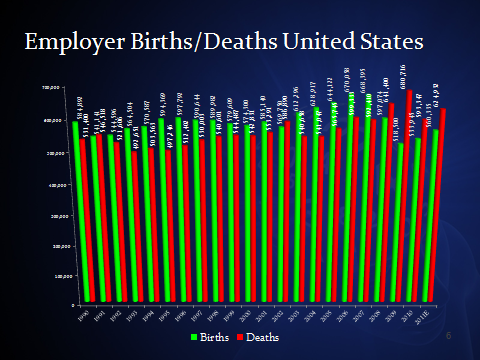
The red bars represent annual deaths for the period 1990 to 2011 while the green bars represent annual births. As you can see on the chart, deaths are running well ahead of births and unlike all of the other years for which data is presented there doesn’t appear to be any change coming to correct these negative trends for the near future.
The next 2 charts really startled me. With the exception of the years 1991 and 2002, every single year charted [independent of the overall state of the United States economy] recorded more business births than deaths in the United States economy over the past 20+ years. In fact, several years had 75,000 to nearly 100,000 more births annually than deaths over the period 1990 to 2011. The green line below documents annual business births; the redline business deaths annually.
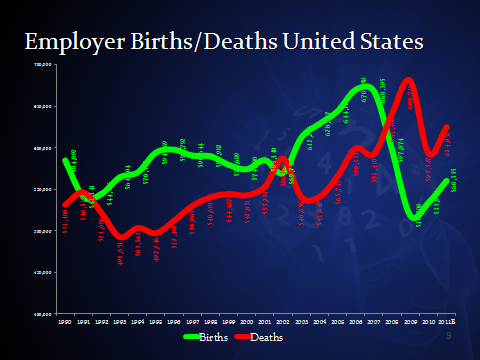
But starting in 2008, the bottom literally has fallen out from under the business birth track record in the United States. Over the past 4 years alone [2008 to 2011E], there have been more than 330,000 more business deaths than births in the United States. This record number essentially wiped out the surplus of births over deaths all the way back to 2003.
Finally, look at the facts and trends for this unprecedented imbalance of business deaths to births.
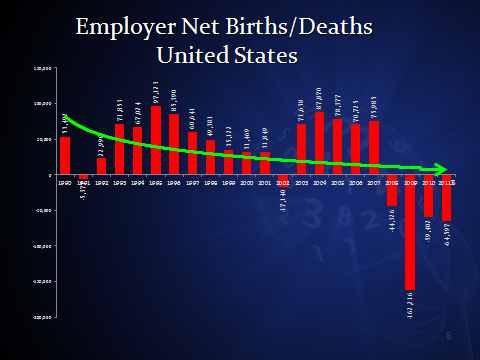
There has never been a period of business death to birth imbalance in the United States like what has occurred over the past 4 years or so. Dating back as far as 1990, every year where business deaths exceeded births was followed with either a 5 or 10 year rebound in the births well exceeding annual business deaths, Assuming the data for 2012 and 2013 is not materially different, this 6 year run of the loss of businesses has never been seen before in our recent economic history.
So the obvious question is this: why does this even matter? It matters for many important reasons, including the following:
- As already documented, small businesses are truly the backbones of the United States economy. When they fail or suffer, the economy follows suit immediately.
- Equally important is the fact that new businesses are also one of the most important forces for innovation in the United States economy. Think about just a couple of the amazing start up stores that come to mind like Facebook, google, etc. and it is very hard to argue against this fact.
- Not only are small businesses among the most creative and entrepreneurial forces present in our economy, they also lead in new technology and patent creation in the United States.
A recent report entitled “An Analysis of Small Business Patents by Industry and Firm Size” funded by the SBA documented that small businesses produced 16 times more patents per employee than large firms did. 16 times!
There are also several other very important points to consider about this unsettling trend or imbalance between business deaths and births. When small businesses fail for whatever reason, there can be a chain reaction impact on the personal credit and net worth of the owners of the failed business. In addition, when small businesses fail, they cannot benefit from the growing percentage of work now being awarded to small business by the Federal, State and local governmental entities. In fiscal 2012 alone over 22% of all contracting dollars went to small businesses according to the SBA. The Department of Defense accounted for the majority of the small business procurement.
So the fact that business deaths remain well above annual birth rates today helps shed some light on why the current “recovery” has been so anemic when looking at net job creation, capital investment, expansion, need for credit, etc. Until this imbalance changes, it will be very difficult for the United States recovery to gain momentum on a sustainable basis.
Are you a small business in need of financial flexibility? You may be a perfect candidate for accounts receivable factoring. Contact us to discuss your options.
